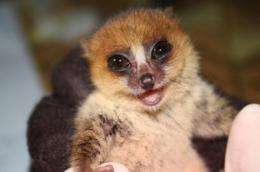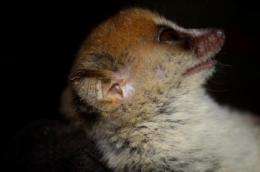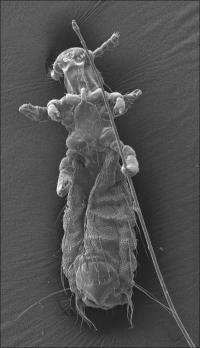Scratching the surface of social interaction

It can be difficult to uncover the behavior of small, shy, nocturnal primates like the brown mouse lemur (Microcebus rufus), especially in the dense rainforests of Madagascar where this lemur lives. New research published in BioMed Central's open access journal BMC Ecology shows that the social interactions of brown mouse lemurs can be monitored by mapping the transfer of tagged lice.
Brown mouse lemurs are the only known host of the parasitic louse Lemurpediculus verruculosus. The lice have evolved to stay attached to the sparse hair on the lemurs' ears, where they feed on the lemur's blood, and can only survive for a few hours if separated from their host. Most transfer of lice between hosts is therefore by direct contact. Sarah Zohdy from the University of Helsinki tagged individual lice from trapped lemurs using colored nail varnish to see if they were transmitted during social interactions between hosts in the wild.

The team of researchers from Finland, USA, and Madagascar, found that the lice were transferred between 43% of the population – all of them males. The lice were found on their ears, testes, and eyelids and the pattern of louse transfer provided new information about the habits of these hard-to-study creatures.
Sarah Zohdy explained, "Male lemurs are known to share nest-holes (and lice) however louse transfer peaked during the breeding season, indicating a greater number of social interactions - probably conflicts over females. There was no overall association between age and louse transfer. The youngest male in the study had the worst louse infestation, but only donated one louse, indicating a low number of interactions, while the eldest male, who also had a heavy infestation, appeared to be more sociable, collecting lice from many donors. Other males appeared to be 'superspreaders' donating but not collecting lice."

The pattern of transferred lice mapped on to animal catch sites also showed that lemurs travel much greater distances and interact over a wider geographic area than previously thought.
In Madagascar the use of tagged lice has provided an extraordinary insight into the life of the brown mouse lemur (and the natural movement of parasites) in their natural habitat. Given the success of parasites throughout the animal kingdom this technique has the potential to find new (if itchy) information about other elusive animals.
More information: Mapping the Social Network: Tracking lice in a wild primate (Microcebus rufus) population to infer social contacts and vector potential. Sarah Zohdy, Addison D Kemp, Lance A Durden, Patricia C Wright and Jukka Jernvall. BMC Ecology (in press)
Provided by BioMed Central
















